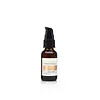What's inside
What's inside
 Key Ingredients
Key Ingredients

 Benefits
Benefits

 Concerns
Concerns

 Ingredients Side-by-side
Ingredients Side-by-side

Sodium Hyaluronate
HumectantCamellia Sinensis Leaf
PerfumingNiacinamide
SmoothingLeuconostoc/Radish Root Ferment Filtrate
AntimicrobialPanthenol
Skin ConditioningLactobacillus Ferment
Skin ConditioningGluconolactone
Skin ConditioningAcetyl Glucosamine
Skin ConditioningSodium Salicylate
PreservativeGlycerin
HumectantGlycyrrhiza Glabra Root Extract
BleachingCamellia Sinensis Extract
AntioxidantBeta-Glucan
Skin ConditioningPolygonum Aviculare Extract
EmollientCucumis Sativus Fruit Extract
EmollientGalactooligosaccharides
HumectantSodium Bicarbonate
AbrasiveWater
Skin ConditioningCurcuma Xanthorrhiza Root Extract
Daucus Carota Sativa Root Extract
Skin ConditioningSodium Hyaluronate, Camellia Sinensis Leaf, Niacinamide, Leuconostoc/Radish Root Ferment Filtrate, Panthenol, Lactobacillus Ferment, Gluconolactone, Acetyl Glucosamine, Sodium Salicylate, Glycerin, Glycyrrhiza Glabra Root Extract, Camellia Sinensis Extract, Beta-Glucan, Polygonum Aviculare Extract, Cucumis Sativus Fruit Extract, Galactooligosaccharides, Sodium Bicarbonate, Water, Curcuma Xanthorrhiza Root Extract, Daucus Carota Sativa Root Extract
Water
Skin ConditioningNiacinamide
SmoothingGlycerin
HumectantDipropylene Glycol
HumectantPropanediol
SolventDimethicone
EmollientCyclodextrin
AbsorbentMethylpropanediol
SolventSodium Palmitoyl Proline
Skin ConditioningPentylene Glycol
Skin ConditioningCaprylyl Glycol
EmollientPhenoxyethanol
PreservativeSodium Polyacrylate
AbsorbentButyrospermum Parkii Butter
Skin ConditioningPolysilicone-11
Ammonium Acryloyldimethyltaurate/Vp Copolymer
Butylene Glycol
HumectantCannabigerol
Skin ConditioningCannabidiol - Synthetically Produced
AntioxidantSodium Phytate
Camellia Sinensis Leaf Extract
AntimicrobialPalmitoyl Hexapeptide-52
Skin ConditioningPassiflora Incarnata Extract
AstringentDecyl Glucoside
CleansingSea Water Extract
Skin ConditioningN-Prolyl Palmitoyl Tripeptide-56 Acetate
Skin ConditioningWater, Niacinamide, Glycerin, Dipropylene Glycol, Propanediol, Dimethicone, Cyclodextrin, Methylpropanediol, Sodium Palmitoyl Proline, Pentylene Glycol, Caprylyl Glycol, Phenoxyethanol, Sodium Polyacrylate, Butyrospermum Parkii Butter, Polysilicone-11, Ammonium Acryloyldimethyltaurate/Vp Copolymer, Butylene Glycol, Cannabigerol, Cannabidiol - Synthetically Produced, Sodium Phytate, Camellia Sinensis Leaf Extract, Palmitoyl Hexapeptide-52, Passiflora Incarnata Extract, Decyl Glucoside, Sea Water Extract, N-Prolyl Palmitoyl Tripeptide-56 Acetate
 Reviews
Reviews

Ingredients Explained
These ingredients are found in both products.
Ingredients higher up in an ingredient list are typically present in a larger amount.
Glycerin is already naturally found in your skin. It helps moisturize and protect your skin.
A study from 2016 found glycerin to be more effective as a humectant than AHAs and hyaluronic acid.
As a humectant, it helps the skin stay hydrated by pulling moisture to your skin. The low molecular weight of glycerin allows it to pull moisture into the deeper layers of your skin.
Hydrated skin improves your skin barrier; Your skin barrier helps protect against irritants and bacteria.
Glycerin has also been found to have antimicrobial and antiviral properties. Due to these properties, glycerin is often used in wound and burn treatments.
In cosmetics, glycerin is usually derived from plants such as soybean or palm. However, it can also be sourced from animals, such as tallow or animal fat.
This ingredient is organic, colorless, odorless, and non-toxic.
Glycerin is the name for this ingredient in American English. British English uses Glycerol/Glycerine.
Learn more about GlycerinNiacinamide is a multitasking form of vitamin B3 that strengthens the skin barrier, reduces pores and dark spots, regulates oil, and improves signs of aging.
And the best part? It's gentle and well-tolerated by most skin types, including sensitive and reactive skin.
You might have heard of "niacin flush", or the reddening of skin that causes itchiness. Niacinamide has not been found to cause this.
In very rare cases, some individuals may not be able to tolerate niacinamide at all or experience an allergic reaction to it.
If you are experiencing flaking, irritation, and dryness with this ingredient, be sure to double check all your products as this ingredient can be found in all categories of skincare.
When incorporating niacinamide into your routine, look out for concentration amounts. Typically, 5% niacinamide provides benefits such as fading dark spots. However, if you have sensitive skin, it is better to begin with a smaller concentration.
When you apply niacinamide to your skin, your body converts it into nicotinamide adenine dinucleotide (NAD). NAD is an essential coenzyme that is already found in your cells as "fuel" and powers countless biological processes.
In your skin, NAD helps repair cell damage, produce new healthy cells, support collagen production, strengthen the skin barrier, and fight environmental stressors (like UV and pollution).
Our natural NAD levels start to decline with age, leading to slower skin repair, visible aging, and a weaker skin barrier. By providing your skin niacinamide, you're recharging your skin's NAD levels. This leads to stronger, healthier, and younger looking skin.
Another name for vitamin B3 is nicotinamide. This vitamin is water-soluble and our bodies don't store it. We obtain Vitamin B3 from either food or skincare. Meat, fish, wheat, yeast, and leafy greens contain vitamin B3.
The type of niacinamide used in skincare is synthetically created.
Learn more about NiacinamideWater. It's the most common cosmetic ingredient of all. You'll usually see it at the top of ingredient lists, meaning that it makes up the largest part of the product.
So why is it so popular? Water most often acts as a solvent - this means that it helps dissolve other ingredients into the formulation.
You'll also recognize water as that liquid we all need to stay alive. If you see this, drink a glass of water. Stay hydrated!
Learn more about Water